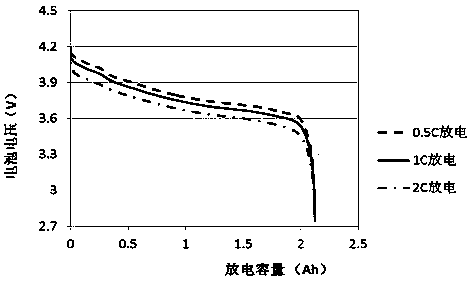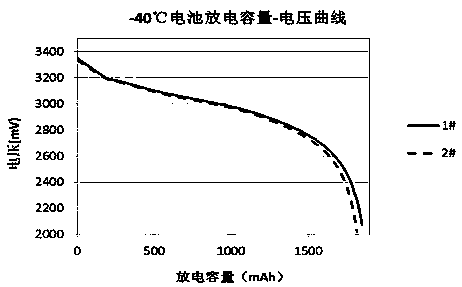Preparation process of lithium ion low-temperature battery
A low-temperature battery and preparation process technology, which is used in the manufacture of electrolyte batteries, secondary batteries, battery electrodes, etc., can solve the problems of short discharge time, inability to discharge, and affect the normal use of batteries, and achieve stable performance and high volume specific energy. Effect
- Summary
- Abstract
- Description
- Claims
- Application Information
AI Technical Summary
Problems solved by technology
Method used
Image
Examples
Embodiment 1
[0017] A preparation process for a lithium-ion low-temperature battery, which includes a positive pole and a negative pole piece, the pole pieces are provided with tabs, and a separator is provided between the positive and negative pole pieces. (1) The thickness of the positive pole piece is 103 μm, and the positive pole piece includes It is composed of lithium cobaltate active material, binder PVDF, conductive agent SP and carbon nanotubes; the weight percentage of positive electrode active material: binder: conductive agent is 94%: 2%: 4%; (2) The thickness of the negative electrode sheet is 105 μm, and the negative electrode sheet includes graphite, a thickener CMC, a binder SBR, a conductive agent SP and carbon nanotubes in the negative electrode sheet. Among them, the negative electrode active material: thickener: binder: conductive agent The weight percentage is 95%: 1.5%: 2%: 1.5%; (3) The positive and negative electrodes are wound to form a core, and then assembled to m...
Embodiment 2
[0022] A preparation process for a lithium-ion low-temperature battery, which includes a positive electrode and a negative electrode sheet, with tabs on the electrode sheet, and a separator between the positive and negative electrode sheets. (1) The thickness of the positive electrode sheet is 105 μm, and the positive electrode sheet includes It is composed of lithium cobaltate active material, binder PVDF, conductive agent SP and carbon nanotubes; the weight percentage of positive electrode active material: binder: conductive agent is 97%: 1%: 2%; (2) The thickness of the negative electrode sheet is 104 μm, and the negative electrode sheet includes graphite, a thickener CMC or HPMC, a binder SBR, a conductive agent SP and carbon nanotubes in the negative electrode sheet. Among them, the negative electrode active material: thickener: binder: conductive The weight percentage of the agent is 93%: 2.5%: 2%: 2.5%; (3) the positive and negative electrodes are wound to form a core, a...
Embodiment 3
[0027] A preparation process for a lithium-ion low-temperature battery, which includes a positive electrode and a negative electrode sheet, with tabs on the electrode sheet, and a separator between the positive and negative electrode sheets. (1) The thickness of the positive electrode sheet is 109 μm, and the positive electrode sheet includes It is composed of lithium cobaltate active material, binder PVDF, conductive agent SP and carbon nanotubes; the weight percentage of positive electrode active material: binder: conductive agent is 96%: 1%: 3%; (2) The thickness of the negative electrode sheet is 110 μm, and the negative electrode sheet includes graphite as the negative electrode active material, thickener CMC or HPMC, binder SBR, conductive agent SP and carbon nanotubes, among which, the negative electrode active material: thickener: binder: conductive The weight percentage of the agent is 94%: 1.5%: 2.5%: 2%; (3) the positive and negative electrodes are wound to form a co...
PUM
| Property | Measurement | Unit |
|---|---|---|
| thickness | aaaaa | aaaaa |
| thickness | aaaaa | aaaaa |
| thickness | aaaaa | aaaaa |
Abstract
Description
Claims
Application Information
 Login to View More
Login to View More - Generate Ideas
- Intellectual Property
- Life Sciences
- Materials
- Tech Scout
- Unparalleled Data Quality
- Higher Quality Content
- 60% Fewer Hallucinations
Browse by: Latest US Patents, China's latest patents, Technical Efficacy Thesaurus, Application Domain, Technology Topic, Popular Technical Reports.
© 2025 PatSnap. All rights reserved.Legal|Privacy policy|Modern Slavery Act Transparency Statement|Sitemap|About US| Contact US: help@patsnap.com


